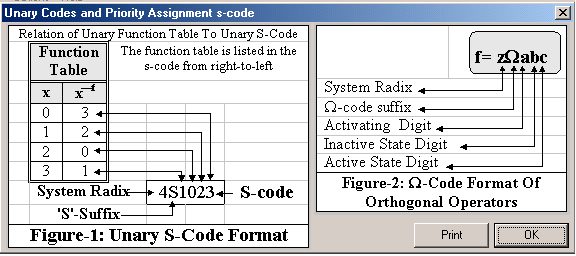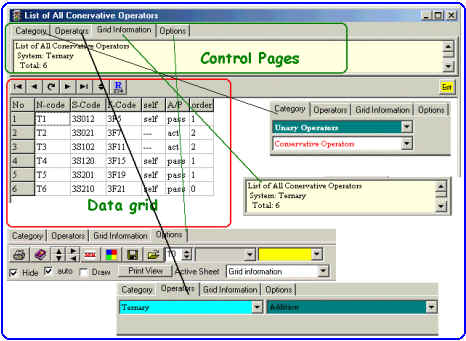|
| |
Unary Operators Software
The unary operators and operations page is displayed below.
The unary page provides 12 services which are:
- Operations
- Codes
- Lists
- Conservative Operators
- Self-Inverse Operators
- Constant Operators
- Complete list of unary operators
- Complete list of unary operators base on category
- Orthogonal Operators
- Biogonal operators
- Triogonal operators
- All-in-separate files
- All-in-single file
The operations service provides you with six panels which are "The Three
Basic Unary Operations", "Unary Sequential Operations",
"System","Orthogonal Operations", "Unary Image
Operations", and "Control Panel".

- The Three Basic Unary Operations
When you select a conservative unary operator from the yellow combo
box  , the the inverse, star
and costar of the selected operators are displayed automatically.
If you doubt some results press the , the the inverse, star
and costar of the selected operators are displayed automatically.
If you doubt some results press the  bottom. To view the function table of any resulted operator just
press the corresponding bottom. To view the function table of any resulted operator just
press the corresponding  bottom. The output 'T1=3S012 s2: means it is T1 conservative unary
operator with "3S012" s-code and 'S2' attribute code where 's' means
self-inverse (inverter), 'a' means a none-self inverse (converter), '2' is the maximum
order of the operator.
bottom. The output 'T1=3S012 s2: means it is T1 conservative unary
operator with "3S012" s-code and 'S2' attribute code where 's' means
self-inverse (inverter), 'a' means a none-self inverse (converter), '2' is the maximum
order of the operator.
Unary Sequential Operations
Use this panel to evaluate f-y  and y-f and y-f  . In . In  set the value of
"f" and in set the value of
"f" and in  set the value of "y". Use set the value of "y". Use  to reset the value of of each
operator to UpDel operator and use to reset the value of of each
operator to UpDel operator and use  to view the function table of each operator. The result for f-y
is
to view the function table of each operator. The result for f-y
is  and for y-f
is in and for y-f
is in  . .
System
Use this panel to set the current radix to binary, ternary, or quaternary
systems. Higher radii are not supported because these first three radii are the
most important for digital design and they contain the optimum radix which is
"4" based on my solution. When the radix changes, the entire
data will be lost and all panels are rested. If you need the data, print
it before changing the radix.
Orthogonal Operations
Use this panel to evaluate the image of an input to any orthogonal
operator. Select the orthogonal operator from . The first field is
the index of the selected operator, the second field e.g. '^001' are the unary
operator in orthogonal code, and the third field e.g. 3S001 is the s-code of the
orthogonal operator. The "input" and "output" are
shown in . The first field is
the index of the selected operator, the second field e.g. '^001' are the unary
operator in orthogonal code, and the third field e.g. 3S001 is the s-code of the
orthogonal operator. The "input" and "output" are
shown in  .
Use up/down arrows in .
Use up/down arrows in  to select the input value. The output will be
reflected immediately. to select the input value. The output will be
reflected immediately.
Unary Image Operation
Use this panel to evaluate the image of an input to any unary operator.
Select the unary operator form  . The first field is the
index of the selected operator, the second field e.g. '3S000' is the s-code of
the selected unary operator. The "input" and "output"
are shown in . The first field is the
index of the selected operator, the second field e.g. '3S000' is the s-code of
the selected unary operator. The "input" and "output"
are shown in  .
Use up/down arrows in .
Use up/down arrows in  to select the input value. The output will be
reflected immediately. to select the input value. The output will be
reflected immediately.
In control panel  , use , use  to print an image to the entire window with its current
data. To print function table use to print an image to the entire window with its current
data. To print function table use  and use the print service provided with it. You also can save the table to
a disk file in text mode. Use
and use the print service provided with it. You also can save the table to
a disk file in text mode. Use  to reset all the operators
for all panels. To reset a special panel, use its reset bottom. Use to reset all the operators
for all panels. To reset a special panel, use its reset bottom. Use  to update
all results in all panels. Use to update
all results in all panels. Use  to abort the current
operation and exit the window. to abort the current
operation and exit the window.
Code displays the formats of the s-code and orthogonal code as follows:

All the following are displayed by the same window.
Conservative Operators, Self-Inverse Operators, Constant Operators,
Complete list of unary operators, Complete list of unary operators base on category,
Orthogonal Operators, Biogonal operators, Triogonal operators
|
The screen to the right shows list menu. The top panel contains the control
elements and the lower panel contains the data grid with its navigation bottoms.
Use the option page for further command on the data grid. Such as print,
save, control grid size, colors, and font size.
|

|
The "grid information" page contains details on the grid columns in
addition to the grid headings. This window is used throughout the program to
display lists of operators and information. The image shown lists the
"conservative unary operators" in the ternary system.
"No" column shows the serial number of each operator. The
'N-code' column shows the serial code for each operators. The F-code shows
the f-code of each operator. The "self" column displays the word
"self" if the operator is a self conservative. The "A/P"
displays 'pass" if the operator is passive and 'act' if it is active.
The order shows the maximum cyclic order of each operator.
All-in-separate files
This shows all lists provided in separate text files.
All-in-single file
This shows all lists provided in one single text files.
|